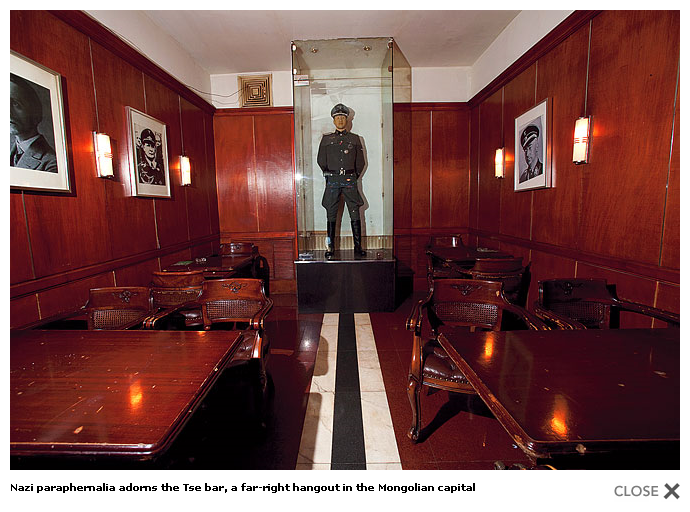 |
|
|
|
In the Mongolian capital Ulan Bator, "Shoot the Chinese" is spray-painted on a brick wall near a movie theater. A pair of swastikas and the words "Killer Boys ...! Danger!" can be read on a fence in an outlying neighborhood of yurt dwellings. Graffiti like this, which can be found all over the city, is the work of Mongolia's neo-Nazis, an admittedly implausible but often intimidating, and occasionally violent, movement.
Ulan Bator is home to three ultra-nationalist groups claiming a combined membership of several thousand — a not insignificant number in a country of just 3 million people. They have adopted Nazi paraphernalia and dogma, and are vehemently anti-Chinese. One group, Blue Mongolia, has admitted to shaving the heads of local women found sleeping with Chinese men. Its leader was convicted last year of murdering his daughter's Mongolian boyfriend, who had merely studied in China. See pictures of race riots continue in China's far west.
The neo-Nazis may be on society's fringe, but they represent the extreme of a very real current of nationalism. Sandwiched between Russia and China, with foreign powers clamoring for a slice of the country's vast mineral riches, many Mongolians fear economic and ethnic colonization. This has prompted displays of hostility toward outsiders and slowed crucial foreign-investment negotiations.
Fifty-year-old Zagas Erdenebileg is the leader of Dayar Mongol (All Mongolia), the most prominent of the neo-Nazi groups. "If our blood mixes with foreigners', we'll be destroyed immediately," says Erdenebileg, who has run unsuccessfully for parliament four times. He loathes the Chinese — whom he accuses of involvement in prostitution and drug-trafficking — and reveres Genghis Khan, who he says influenced Adolf Hitler. I ask him if he considers his adoption of the beliefs of a regime that singled out and executed people with Mongol features from among Soviet prisoners of war to be in any way ironic. "It doesn't matter," he shrugs. "We share the same policies."
If Erdenebileg is the elder statesman of Mongolia's neo-Nazis, Shari Mungun-Erdene, the 23-year-old leader of the roughly 200-strong Mongolian National Union (MNU), is the new kid on the block and sports a swastika tattoo on his chest. The MNU takes vigilante action against law-breaking outsiders, Mungun-Erdene says, mainly Chinese. When I ask what kind of action, he replies, "Whatever it takes so that they don't live here." At other times, though, he comes across as an overzealous adolescent. He opens his laptop to show photos of his neo-Nazi buddies. But beside the folders entitled "Guns" and "Skinheads" are others with names like "My Car" and "Mom in Japan."
Dagva Enkhtsetseg, program manager for the Open Society Forum, an Ulan Bator – based organization that promotes public participation in civic life, points out that the neo-Nazis don't enjoy broad support. A graduate in Mongolian nationalism, she argues that hard-line nationalism's allure is subsiding as more young Mongolians are exposed to globalization or study abroad. That was evident during the presidential election in May, when bogus accusations that Democratic Party leader and eventual winner Tsakhiagiin Elbegdorj was part Chinese fell on deaf ears. "In the past that would have worked," Enkhtsetseg says.
The neo-Nazis still pose some threats, however. In May, a newsletter of the international development charity Voluntary Service Overseas reported allegations that two Peace Corps volunteers were "severely beaten" outside a pub after a confrontation with Dayar Mongol members. (Erdenebileg denies his group's involvement.) One 25-year-old American living in Ulan Bator, who didn't wish to be named, said he was accosted by neo-Nazis at a nightclub for cavorting with a Mongolian woman. "After they showed a swastika, my initial thought was, This isn't going to be a normal fight," he says. "They wanted to send a message." That message, delivered by spray paint or fists, translates to "get out."







